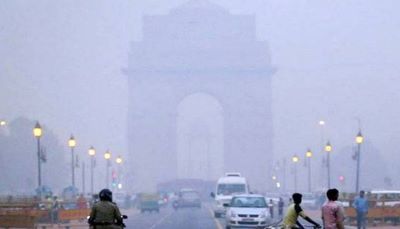Context
As the southwest monsoon comes to an end, northern India, especially the Indo-Gangetic plains, prepares for the annual rise in winter pollution. Recently, a senior official from the Prime Minister's Office held a meeting with representatives from Delhi, Haryana, Punjab, Rajasthan, and Uttar Pradesh, along with several ministry heads, to review measures aimed at preventing a severe decline in air quality in Delhi.
Overview
· While vehicular emissions, dust from roads and construction, improper waste management, and diesel generators have long been identified as major pollution sources.
· The burning of paddy stubble in Punjab and Haryana accounts for nearly 40% of pollutants during October and November. Punjab is projected to produce 19.52 million tonnes of paddy straw this year, compared to Haryana's 8 million tonnes.
· Last November, the Supreme Court ordered a complete cessation of stubble burning practice and has since asked the Centre about measures taken to tackle the issue.
Observation
During the 2023 harvest season, Punjab reported a 59% decrease in stubble-burning incidents compared to 2022, while Haryana saw a 40% drop. However, Uttar Pradesh experienced a 30% increase.
Government measures to curb air pollution in NCR
· Graded Response Action Plan (GRAP): A structured framework that details specific actions based on pollution levels, including restrictions on construction activities and vehicular movement.
· Odd-Even Scheme: A traffic management strategy that limits vehicle usage according to their registration numbers on alternate days to alleviate congestion and emissions.
· Enhanced Public Transport: Expansion and improvement of public transportation options, such as buses and metro services, to reduce dependence on private vehicles.
· Anti-Dust Initiatives: Implementation of guidelines aimed at controlling dust from construction sites, including mandatory water sprinkling and the use of dust suppressants.
· Paddy Stubble Management: Programs providing financial incentives and machinery to farmers to manage crop residue without burning.
· Electric Vehicle Promotion: Offering subsidies and incentives for the adoption of electric vehicles to decrease reliance on fossil fuel-powered transportation.
· Monitoring and Enforcement: Strengthening pollution monitoring systems and enforcing regulations on industries and construction activities.
· Awareness Campaigns: Initiatives aimed at educating the public about pollution and promoting sustainable practices.
· Collaboration with Neighboring States: Working with states like Punjab and Haryana to tackle cross-border pollution issues.
Although solutions such as economic incentives and punitive measures to prevent burning are known, implementation remains challenging.
· Punjab aims to manage 11.5 million tonnes of paddy straw through in-situ crop residue management and the remainder through ex-situ methods.
· Haryana plans to manage 3.3 million tonnes in-situ and use ex-situ methods for the rest.
· Additionally, 2 million tonnes of paddy straw will be co-fired in 11 thermal power plants across the NCR region, where straw is converted into pellets for carbon usage.
· However, historical experience indicates that necessary machinery often isn't available to farmers when needed, and there is no efficient system to transport straw from fields to power plants. The pollution crisis is complex and will take time to resolve. It is essential for the states and the Centre to set aside political differences and work together toward a solution.
Way forward
· Enhancing Policy Frameworks: Enforcing stricter regulations on emissions from industries, construction activities, and vehicles.
· Fostering Green Infrastructure: Expanding green spaces, urban forests, and rooftop gardens to enhance air quality.
· Promoting Clean Energy Solutions: Encouraging the adoption of renewable energy sources in homes and industries to lessen dependence on fossil fuels.
· Coordinated Regional Collaboration: Working with neighboring states to jointly tackle pollution sources, particularly during crop burning seasons.
· Raising Public Awareness: Initiating campaigns to inform citizens about pollution sources and promote sustainable practices.
· Investing in Innovative Technologies: Supporting research and development of pollution control technologies and cleaner production techniques.
· Upgrading Monitoring Systems: Improving air quality monitoring networks to provide real-time data and enhance accountability.
· Advocating Sustainable Agricultural Practices: Encouraging alternative methods for managing crop residue to reduce stubble burning.
Conclusion
As the southwest monsoon concludes, northern India braces for a surge in winter pollution, particularly from stubble burning, which accounts for a significant portion of the pollutants. Despite a decline in stubble-burning incidents in Punjab and Haryana, challenges remain, including ineffective machinery availability and transportation logistics for crop residue management. The government's multifaceted approach, including the Graded Response Action Plan, traffic management schemes, and public awareness campaigns, seeks to address these issues. Moving forward, stricter regulations, green infrastructure, clean energy adoption, and regional collaboration will be vital in combating air pollution and achieving sustainable solutions. Collective action among states and the Centre is essential for meaningful progress.
|
Probable questions for upsc mains examination 1. Discuss the primary causes of air pollution in the National Capital Region (NCR) and their impact on public health. 250 words (15 marks) 2. Evaluate the effectiveness of the Graded Response Action Plan (GRAP) in managing air quality in Delhi and its surrounding areas. 150 words (10 marks) |
Source: The Hindu








